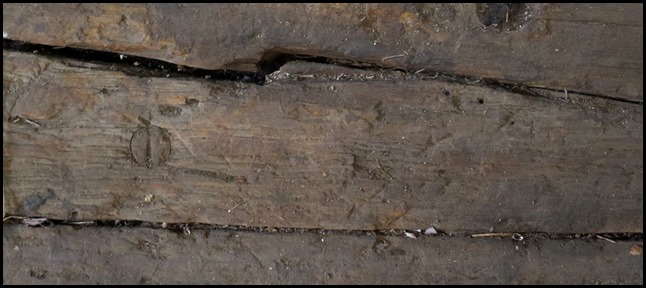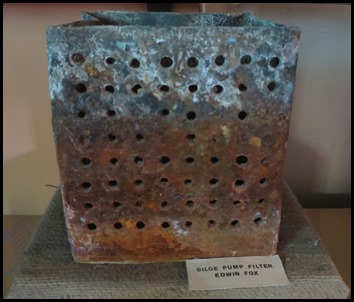Edwin Fox 'downstairs'

Beez Neez now Chy Whella
Big Bear and Pepe Millard
Fri 19 Sep 2014 22:07
|
A Downstairs Bimble
 As we trotted down the steps we saw
the massive space unfold before us.
The Hold:
This section of the ship has held many interesting cargoes. Imagine working to
load or unload any of the following:- rice, tea, jute, sugar and spices from
1853. Cannons, gun powder, tents, food, muskets and medical supplies for the
Crimean War from 1853-1856. Supplies and an extra deck of convict cells on the
trip to take British convicts to Western Australia in 1858. Immigrants
belongings and food to New Zealand in the 1870’s. Wool, flax and whale oil from
New Zealand to Britain.
   Bear is dwarfed by the remains of
the massive timber main mast.
The Main
Mast: The mast mast was made of deodar cedars – cedrus deodara, that grew
in the Indian Himalayas. It was in three sections and a total height of one
hundred and sixty feet. The foremast was one hundred and forty feet and the
mizzen one hundred and ten. Upper sections of the mast were removed when the
Edwin Fox began serving the mutton industry as a freeze hold.
 Draught:
The lower marker shows the unladen draught as fourteen feet. The upper marker
shows the laden draught as approximately twenty two feet, six
inches.
 Erosion on the
Stanchions: While the ship lay on the beach for twenty odd years in
Shakespeare Bay, Queen Charlotte Sound, she lay with a starboard list. The
deterioration which took place as a result of the movement of the tides can be
seen as having a slanting effect both on the stanchions and on the masts. Those
parts which were under water most of the time were protected while those at the
water line and above have suffered the most.
 The
Ceiling: The ‘ceiling’ provides an inner lining over the frames from the
upper airway down to the lower airway, both of which extend the entire length of
the ship. The ceiling is attached to the frames by means of iron or wooden
fastenings – trunnels. As with most parts of the ship, the ceiling is made of
teak, which was obtained from the forests of Northern India and
Burma.
  As we bimbled the length of the ship
we couldn’t believe the age of the Edwin Fox. Such good
condition considering.
 Scarph
Joint: This example of a scarph joint shows that these joints were
designed to hook together. This manner of connecting timbers in a ship provides
a more secure method of ensuring a solid and firmly built structure which will
stay together in heavy seas.
 Sadly, her back
end, port side has not faired so very well.
   Bits and
bobs.
  The
Bilges: This space under the inner skin of the hull was where water
leaking through the seams in the outer planking could collect, the water was
polluted with the accumulation of rubbish that came from past cargoes as well as
every type of human waste imaginable from above. It was important to keep the
bilges clear of water to avoid damaging the cargo and lighten the ship. The crew
– and if necessary, male passengers were called to “man the pumps” to remove the
bilge water.
 The way to
remember this lady must be as she was first seen on the high
seas.
   After being amazed on board the Edwin Fox we
looked at all kinds of interesting things en route
back to the museum.
 Bear did a really poor ‘I see no ships’,
well the sun was really bright. His left
hand was clutching a fisherman's anchor, rather
similar to the one lashed to the deck of Beez Neez. Our anchor has a bit of a
story to it. I ‘retired’ a little while before Bear. My job was to complete all
pink jobs prior to our departure. Bear seemed to see this as carte blanche to
use me as his postal receiver for all packages of all shapes and sizes. One day
I was decanting gravy powder when the buzzer went. I pressed the door video and
saw a very red-faced Bill, puffing he managed
“Hi Pepe, he’s been at it again”. I said I would be right down and with that was
in the lift in a flash, pressing G. Out of the lift through the fire door, down
the to steps and to the front door. Well I never, there was
Bill not looking very amused. I opened the door and could tell this
lovely, mild-mannered man was straining at the bit. His whole leg was propping
up a brown paper covered anchor. I apologised profusely and promised to rein
Bear and his purchases in. He finally managed to calmly tell me that other than
the obvious weight and awkwardness of this particular delivery, the protective
sponges at the pointy ends had come off sometime during the hefting and they
kept biting his ankles. I felt for the man, postmen shouldn’t have to put up
with this malarkey. I smiled - my very best, but I couldn’t break this poor mans
icy veneer. I asked if he would possibly help me to the lift. No. What about to
the steps. No. The sad thing was I never saw Bill again............. Needless to
say, my sole fighting with this piece of equipment took quite while. Dragging
sixty pounds up the two steps, to the fire door that wanted to swing back at me
before I could manipulate things. That done I had to wait for the lift, drag the
‘thing’ in, press five and wait. Drag it from lift all the way to our front
door. Down the hall, cunning plan, hide it in the under stairs cupboard. Later,
Bear you have a parcel. Oh do I how exciting. Where is
it. In the cupboard. OH and
several words I cannot possible repeat.......... Do you think this stopped him
ordering on line ??? What do you think................Thankfully we left three
months later. A heartfelt sorry to all the postmen in
Plymouth.
  This is the spare
propeller of the whale catcher S.S. Orca
which was owned and operated by the Perano whaling station situated at the entrance of Tory Channel. The Orca
was built in Oslo, Norway and converted into a German minesweeper during
World War Two. She weighed three hundred and ninety five tons, fitted with a
triple expansion steam engine. Post-war saw Orca whaling in the
Antarctic as well as Queensland and later delivery to the Peranos in February
1963. On the 28th of April 1963, Jon Perano caught the first sperm whale from
the Orca, this was the first of two hundred and forty eight. The Tory
Channel whaling operation ceased on the 22nd of December 1964 and the Orca
was broken up for scrap metal at Picton in October 1966. The propeller is
four-bladed with an overall diameter of three meters.
 Just outside the museum back door was a pile
of ballast iron from the Edwin Fox.
ALL IN ALL JUST
INCREDIBLE |